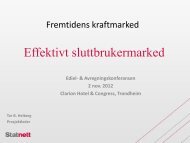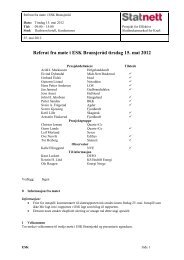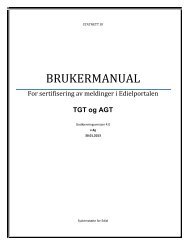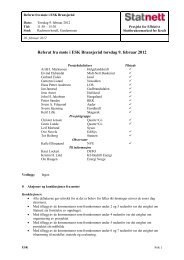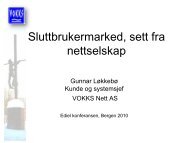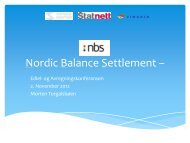2. Simple Combined Billing
2. Simple Combined Billing
2. Simple Combined Billing
Create successful ePaper yourself
Turn your PDF publications into a flip-book with our unique Google optimized e-Paper software.
<strong>Combined</strong> <strong>Billing</strong> in a<br />
Supplier Centric Model<br />
Different models<br />
Arnstein Flaskerud
Definition – <strong>Combined</strong> <strong>Billing</strong> in a Supplier Centric Model<br />
- the DSO invoice the customer via the supplier<br />
1. Joint <strong>Billing</strong> - <strong>Combined</strong> settlement and combined billing<br />
<strong>2.</strong> <strong>Simple</strong> <strong>Combined</strong> <strong>Billing</strong> - Separate settlement and combined billing<br />
3. Telecom Model - Separate settlement and grid fee handled as ‘cost of goods sold’
<strong>Combined</strong> <strong>Billing</strong> – main challenges<br />
•How to gain simplicity for both the customer, supplier and DSO<br />
•Gaining overall cost savings for supplier and DSO<br />
•Grid fee handling<br />
•Taxes handling<br />
• Energy taxes<br />
• VAT<br />
•How to organize contractual issues and what to be stipulated in legislation and<br />
standard contracts.<br />
•Increased risk of non-payment for the supplier (Grid fee, energy taxes and vat)<br />
•Risk of non-payment for the DSO
Definition – <strong>Combined</strong> <strong>Billing</strong><br />
- the DSO invoice the customer via the supplier<br />
1 – Joint <strong>Billing</strong><br />
<strong>Billing</strong> prosess DSO Supplier<br />
Collecting data<br />
Settlement<br />
<strong>Combined</strong> settlement<br />
and combined billing<br />
• The supplier settles the grid fee,<br />
power cost and public fees<br />
• The DSO invoice the supplier<br />
• The supplier invoice the customer<br />
for the grid fee, power cost and<br />
public fees<br />
Bill proposal<br />
Invoicing<br />
B2B Bill<br />
Payment<br />
Payment<br />
collection
1 – Joint <strong>Billing</strong><br />
Major Strengths<br />
• Simplicity for the customer<br />
• Clear roles between the supplier and DSO<br />
• Simplicity for the DSO regarding customer<br />
dialog, systems and billing process.<br />
Major Weaknesses<br />
• The supplier must run complex sector adapted<br />
systems<br />
• Complex process exchanges between DSO and<br />
supplier during the billing process<br />
• The suppliers risk related to non-payment<br />
increases significantly<br />
• DSO will require a full payment guarantee from<br />
the supplier<br />
Major Opportunities<br />
• Restructuring of the downstream energy sector<br />
• Reduced number of DSOs and suppliers<br />
• <strong>Simple</strong>r contract regime with only one customer<br />
contract<br />
Major Threats<br />
• Requires that the supplier takes over the<br />
responsibility for the Energy taxes<br />
• Requires harmonization of the grid fees and<br />
invoice periods<br />
• Requires standardized and harmonized<br />
communication between the actors<br />
• Requires that the parties’ rights and obligations<br />
become stipulated in legislation.
Definition – <strong>Combined</strong> <strong>Billing</strong><br />
- the DSO invoice the customer via the supplier<br />
2 - <strong>Simple</strong> <strong>Combined</strong> <strong>Billing</strong><br />
<strong>Billing</strong> prosess DSO Supplier<br />
Collecting data<br />
Settlement<br />
Separate settlement and<br />
combined billing<br />
• The DSO settles the grid fee<br />
• Public fees can be handled by any part<br />
• The supplier settles the power cost<br />
• Two contracts – customer/DSO and<br />
customer/supplier<br />
• The supplier buys the grid fee claim<br />
Invoicing<br />
B2B Bill<br />
Payment<br />
• The supplier invoice the customer for the<br />
grid fee, power cost and public fees<br />
Payment<br />
collection
2 - <strong>Simple</strong> <strong>Combined</strong> <strong>Billing</strong><br />
Major Strengths<br />
• Simplicity for the customer<br />
• Simplicity for the supplier since the DSO<br />
handles the grid fee settlement<br />
• The supplier can run standard non sector<br />
systems for all customer processes and billing<br />
processes.<br />
• Clear <strong>Simple</strong> process exchange between DSO<br />
and supplier during the billing process<br />
Major Weaknesses<br />
• The DSO must handle the grid fee settlement<br />
and send b2b invoice to the supplier<br />
• The suppliers risk related to non-payment<br />
increases significantly<br />
• DSO will require a full payment guarantee from<br />
the supplier<br />
• Not deductible losses regarding vat connected<br />
to grid fee and taxes<br />
• Not deductible losses regarding energy taxes<br />
Major Opportunities<br />
• Flexibility regarding roles between the supplier<br />
and DSO<br />
• Flexibility regarding who to be responsible for the<br />
Energy taxes<br />
• <strong>Simple</strong>r contract regime with only one customer<br />
contract<br />
Major Threats<br />
• Requires standardized and harmonized<br />
communication between the actors<br />
• Requires that the parties’ rights and obligations<br />
become stipulated in legislation.
Definition – <strong>Combined</strong> <strong>Billing</strong><br />
- the DSO invoice the customer via the supplier<br />
3. Telecom Model<br />
(Integrated <strong>Combined</strong> <strong>Billing</strong>)<br />
<strong>Billing</strong> prosess DSO Supplier<br />
Collecting data<br />
Settlement<br />
Separate settlement and grid<br />
fee as ‘cost of goods sold’<br />
• One contract - between the<br />
customer and the supplier<br />
• The DSO invoice the grid fee as a<br />
‘cost of goods sold’ (wholesale)<br />
• The supplier invoice the customer<br />
for the grid fee, power cost and<br />
public fees.<br />
Invoicing<br />
B2B Bill<br />
Payment<br />
• Grid fee can still be specified at the<br />
customer bill.<br />
Payment<br />
collection
3. Telecom Model<br />
(Integrated <strong>Combined</strong> <strong>Billing</strong>)<br />
Major Strengths<br />
• Simplicity for the customer<br />
• Simplicity for the supplier since grid fee<br />
settlement<br />
• The supplier can run standard non sector<br />
systems for all customer processes and billing<br />
processes.<br />
• Clear <strong>Simple</strong> billing process<br />
• Simplicity for the DSO since the customer<br />
handling reduces from thousands of end users<br />
to a simpler B2B relationship towards the<br />
supplier<br />
• Deductible losses for vat regarding grid fee and<br />
taxes<br />
Major Opportunities<br />
• <strong>Simple</strong>r contract regime with only one customer<br />
contract<br />
• Flexibility regarding displaying the grid fee on the<br />
bill<br />
• Deductible losses regarding energy taxes<br />
Major Weaknesses<br />
• The DSO must handle the grid fee settlement<br />
and send b2b invoice to the supplier<br />
• The suppliers risk related to non-payment<br />
increases significantly<br />
• DSO will require a full payment guarantee from<br />
the supplier<br />
Major Threats<br />
• Requires that the supplier takes over the<br />
responsibility for the Energy taxes<br />
• Requires harmonization of the grid fee periods<br />
and invoice periods<br />
• Requires standardized and harmonized<br />
communication between the actors<br />
• Requires that the parties’ rights and obligations<br />
become stipulated in legislation.
HUB
Data exchange – HUB-example<br />
<strong>Billing</strong> prosess DSO Supplier<br />
Collecting data<br />
Metering data<br />
Settlement<br />
HUB<br />
Invoicing<br />
B2B Bill<br />
B2B Bill<br />
Payment<br />
collection<br />
Payment
HUB – benefits for DSO and supplier<br />
• Single point of data exchange regarding all customer processes (national or Nordic)<br />
• Single point of contact regarding the billing process<br />
• Standardized data exchange formats<br />
• Central storage of data (national or Nordic)<br />
• Flexible, cost efficient end robust solution<br />
• Simplified reporting towards government<br />
• Standardized quality control
Data excahange<br />
Customers life circle<br />
DSO<br />
DSO<br />
DSO<br />
DSO<br />
New customer<br />
Change of<br />
customerdata<br />
Swiching<br />
Moving<br />
<strong>Billing</strong><br />
All messages:<br />
• Customer data<br />
• Metering data<br />
• Aggregated<br />
consumption<br />
• Swiching data<br />
• Taxes clarification<br />
• Elsert clarification<br />
HUB<br />
Supplier<br />
Supplier<br />
Supplier<br />
Supplier



